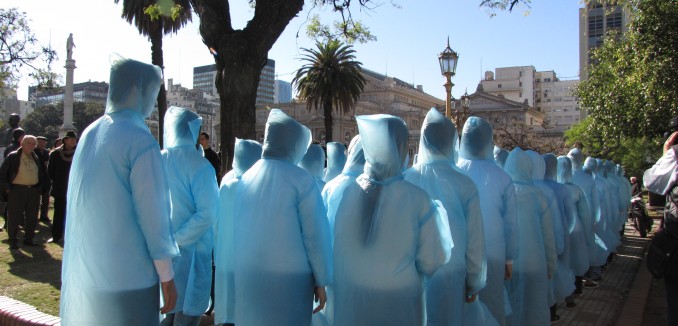On Monday morning, commuters in midtown Manhattan will begin navigating the various barriers and roadblocks that grind the city to a halt every year when the United Nations General Assembly comes to town. Those who find themselves on the length of 42nd Street from the West Side Highway to Second Avenue will be treated to the spectacle of 24 performers dressed in the light blue colors of the UN while walking backwards—a dramatic combination of performance art and political protest targeting the Iranian regime.
The procession is the conception of Mookie Tenembaum, an Argentine-Jewish artist who now resides in Paraguay. Its purpose, Tenembaum told me in an interview, is to highlight the fact that, as he sees it, Western policy towards Iran is now locked into a permanent regression. For that reason, the performers will move backwards in the shape of a horizontal number 8—resembling a symbol that mathematicians sometimes call the “lemniscate,” which represents infinity.
While this may seem like high-minded conceptualism to some, Tenembaum is confident that the visual novelty of watching people walking backwards will grab the attention of passersby. “We live with what I call an ‘attentional crisis’—the methods of getting attention are getting more and more sophisticated,” Tenembaum said. “Because you never see people walking backwards—people don’t walk backwards, animals don’t walk backwards—it captures the attention and connects the artistic display with the political message.”
Since deciphering the political dimension of Tenembaum’s mobile display is probably too much to ask of harassed New York City pedestrians, Monday’s procession will be accompanied by a sign declaring, “Iran Executes People, Not Agreements.” But in Buenos Aires, where the backwards procession, or “Anti-March,” was first staged earlier this year, the display didn’t need any additional embellishment.
“Every year, the Argentine Jewish community asks a different artist to find a way to commemorate the attack on the AMIA building,” Tenembaum explained, referring to the 1994 Iranian-sponsored bombing of the AMIA Jewish center in Buenos Aires—one of the worst anti-Semitic atrocities since the Second World War, in which 85 people lost their lives. As the artist chosen for this year’s ceremony, Tenembaum’s work had an additional resonance coming so soon after the death (likely murder) of Alberto Nisman, the special prosecutor investigating the AMIA bombing who unearthed the murky circumstances behind the Argentine government’s special understanding with Iran to exonerate Tehran over its responsibility for the atrocity.
In Buenos Aires, the spectacle concluded with a recitation of the names of the AMIA victims. In New York, Tenembaum is planning a similar reading once the procession reaches the UN building on Monday. Among the names that will be read out is that of Aaron Plaskin, a respected Hebrew teacher and a close friend of Tenembaum’s father, who perished in the bombing. Other names will include victims of torture and murder in Iran.
I asked Tenembaum—who cites among his principal intellectual influences John Locke, George Orwell, and the libertarian philosopher Robert Nozick —how it feels to work in an artistic milieu molded by Left-wing and post-structuralist theorists like Michel Foucault, Jacques Derrida and Edward Said. “I never care too much about what other artists think,” he laughed. “They hate me in Argentina because I’m not a socialist, I’m not an environmentalist.”
Defining himself primarily as a philosopher, Tenembaum’s libertarian orientation is what informs his approach to Iran, which he regards as similar in many respects to the dictatorships that have disfigured Latin America over the last century. “The difference is that the basic ideology in Iran is suicide, as we saw in the 1980-88 war between Iran and Iraq,” he added. “I’m not talking about individual suicide bombers, but a full army that walks into a minefield in order to clear the way for the units behind them. This is a theocracy that really should scare us all.”
“Backward March: The World Backs Down to Iranian Terror” commences at 9:00 AM on Monday September 28, where 42nd Street meets the West Side Highway, and will continue eastwards to the United Nations building.
[Participants in Mookie Tenembaum’s “Backwards March” artistic protest against Iran gather in Buenos Aires, July 2015. Photo: Mookie Tenembaum]




